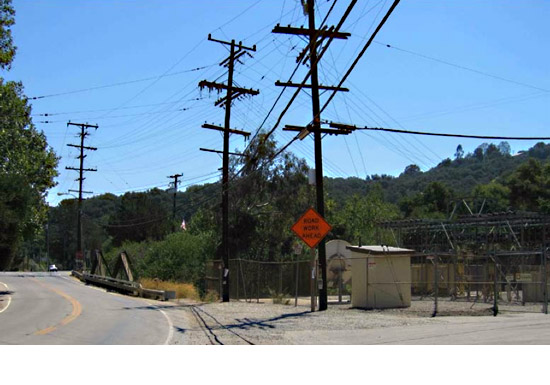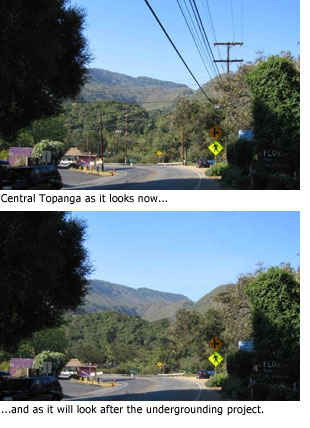Erasing “wire blight” in Topanga
March 8, 2011

It isn’t the sexiest construction project in Los Angeles County. And it won’t be finished until 2014.
But to anyone acquainted with the hazards of fire season—or just the hazards of trying to find an unobstructed view in pretty-but-populous Southern California—the plans taking shape this month in Topanga eventually should offer a whole new perspective.
Next week, the county Department of Public Works and Southern California Edison representatives will launch a series of meetings to discuss the undergrounding of overhead utility lines in the rural community’s central business district around Topanga Canyon Boulevard and Old Topanga Canyon Road.
The $2.4 million project, which will be paid for by a statewide utility fee administered by Southern California Edison in L.A. County, will bury about a third of a mile’s worth of electricity, cable and phone lines that now clutter the view and present ongoing traffic and fire hazards along the right-of-way.
 “The main goal is aesthetic, but there’s also a safety issue,” says Steve Dunn, a senior civil engineer at Public Works. Power poles along winding roads, such as Topanga’s, raise the risk of motor vehicle crashes. And in recent years, at least three massive Southern California brushfires have erupted as tree limbs and lashing utility lines have been blown into overhead power conductors by Santa Ana winds elsewhere in the region.
“The main goal is aesthetic, but there’s also a safety issue,” says Steve Dunn, a senior civil engineer at Public Works. Power poles along winding roads, such as Topanga’s, raise the risk of motor vehicle crashes. And in recent years, at least three massive Southern California brushfires have erupted as tree limbs and lashing utility lines have been blown into overhead power conductors by Santa Ana winds elsewhere in the region.
The project is one of many funded by the California Public Utility Commission’s so-called “Rule 20” program, which combats “wire blight” by helping communities and municipalities bury utility lines. Rule 20 regulates a utility’s recovery of the costs of undergrounding overhead electric equipment and gives local governments dibs on a share of a power company’s capital budget according to the number of rate-payers in each jurisdiction.
The annual amounts are not large—the average cost of an undergrounding project only adds about a nickel a month to the average residential customer’s electric bill, according to SCE—but over time, a municipality’s share can accumulate.
Unincorporated Los Angeles County’s allotment, for instance, amounts to about $3 million annually, which the County then splits among its five supervisorial districts.
The Topanga project will be funded by nearly two decades’ worth of the Third Supervisorial District’s allotment.
Other recent projects include a $4 million undergrounding project in an unincorporated area near Arcadia and a $10 million undergrounding and reconstruction project along 2.6 miles of Rosemead Boulevard.
This month’s meeting, Dunn says, will acquaint the community with the project and launch the environmental documentation. (And notify Topangans, incidentally, that construction is expected to take about 1½ years once it breaks ground in 2013.) The gathering is scheduled for 7 p.m. at the Topanga Elementary Charter School Auditorium.
Posted 3/8/11












 405 bridge work causes a stink
405 bridge work causes a stink
